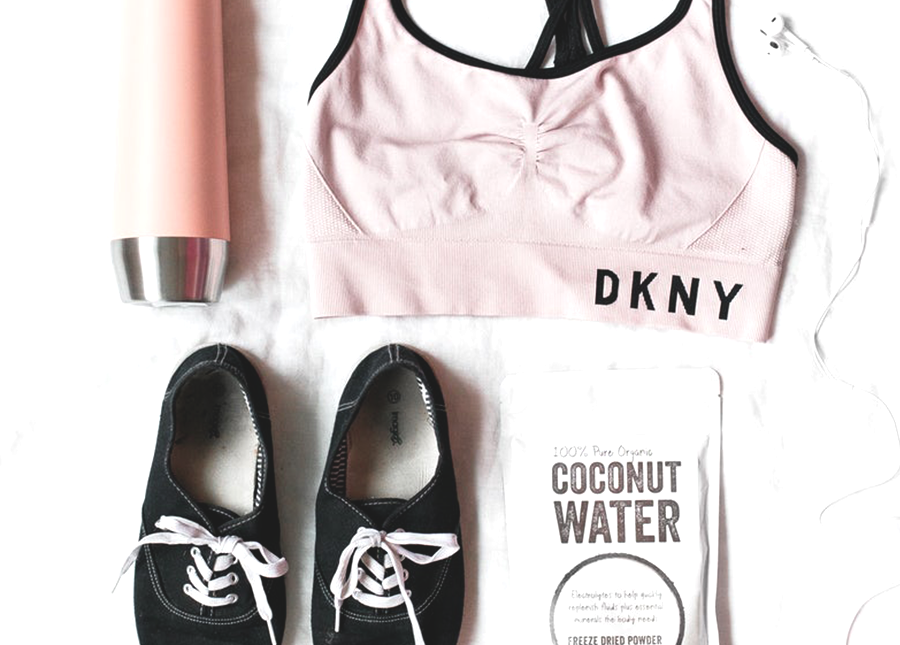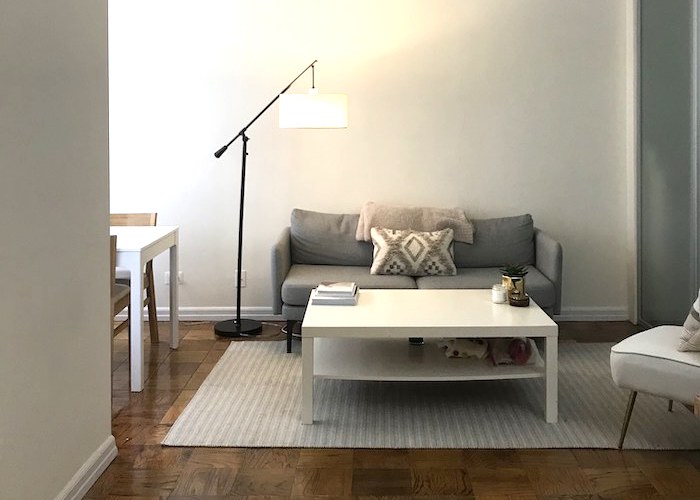6 Changes That Tricked My Brain Into Enjoying Exercise

It has now officially been over seven months since I began working out in earnest, and I say “in earnest” because although my life has always been peppered with just enough physical activity to stave off total shame, I was never pushing my body towards anything near its capacity. When I began my journey into Being A Person Who Regularly Does Pilates, I was almost sure that this effort would degrade in the same way all of my previous efforts towards dedicated, structured, exercise-for-exercise’s-sake had: I would try this new thing, immediately hate it, suffer through a few classes or attempts in spite of that, and eventually give up around session four or five. This had been the case with my C25k app, my TRX classes, my park-based group boot camp, and countless gym memberships whose almost-entirely-wasted membership costs I shudder to reflect on.
But this time, it took: at seven months in, I reliably do Pilates (in a class, or on my mat with a workout checklist if I’m away from my studio) about five times a week. I love it more now than I did when I started, miss it terribly when I’m not able to go, and am seriously considering getting certified to instruct eventually (although that is a big eventually, as the certification for Pilates instruction — particularly reformer-based — is notoriously time-consuming and difficult, and I am nowhere near good enough). Either way, I feel qualified at this point to give advice to someone who was like myself: wanting on some vague level to become a fit person because they know it is good for them, but lacking the drive to get from their current laziness to that effortless mindset of physical activity-as-routine.
And I’m not going to lie to everyone, it’s not terribly easy. There is, unavoidably, a decent amount of unpleasantness to get through to reach the internal rhythm where working out feels effortless and enjoyable. But it most certainly is possible, and mostly involves tricking your brain into not complaining as much as it wants to, or not bailing out at the last minute when pizza and Netflix sounds so much more appealing than going to class. As someone who was formerly profoundly lazy when it comes to working out, I can say that these six changes were incredibly helpful to getting past that initial unpleasantness and getting into the swing of things. I can’t guarantee they will work for everyone, but if you take even one tip away from this and put it to good use, that’s more than enough — when it comes to getting fit, every little bit counts.
1. Starting with someone else.
One of the most obvious ways to trick your brain when it comes to exercising is to give it no easy way out — so much of what allows us to fall off the wagon early in any new fitness regime is the fact that no one gives a shit whether or not we keep going, and therefore saying “eh, I’ll go tomorrow” (which inevitably becomes “never”) is just too easy. My personal way of doing this with Pilates was to pay an eye-searing (for me) amount of money for three private sessions to get the basics, so as to avoid injury/humiliation/total confusion when I eventually went to classes. This was an enormously helpful thing for me, and undoubtedly the key to me keeping up the energy in those early days, but I understand that not everyone can afford to pay for a few private sessions when starting a new workout. But that’s okay! There are Meetup groups for nearly every sport/activity in most major cities, Facebook groups for accountability and workout buddies, and an entire Subreddit dedicated to pairing you up with other Redditors looking for the same thing. No matter what you’re looking to do, with the internet at your disposal and a tiny bit of effort put into the matter, you will be able to find someone with whom you can get started, whether it’s a group of more experienced (but very friendly) athletes, or someone else starting from zero. Creating that forced accountability gets rid of the all-too-tempting “fuck it” button that your brain is so liable to slam in the early days of working out.
2. Forgetting about losing weight.
Here’s the thing about working out: you should basically never do it with the specific intent of losing weight. Countless studies have demonstrated that the connection between working out and losing weight is tenuous at best, and rather often results in weight gain. There are many reasons for this, like the fact that you almost never burn as many calories as you think you’re burning (that hour spent sweating on the stationary bike can easily be undone, calorically, by a single cookie), but also because increased physical activity (especially if you were relatively sedentary before) can mean you overeat frequently without realizing it. The latter happened to me when I started doing Pilates seriously, and it took me a few months to get my eating habits back to just what I needed, rather than slightly more because I was ravenous. Ultimately, if weight loss is your goal, it is going to come down to what you eat. There are a thousand ways to go about doing it, but losing weight will basically always come down to calories consumed vs calories expended, and it is much easier for most people to reduce their intake than to proportionally increase their expenditure. As the saying goes, abs are made in the kitchen. I personally found that it was infinitely easier to focus first on changing my diet (which resulted in weight loss), manage that part of my health entirely, then move onto building strength and endurance through exercise. You may find that starting both at the same time works for you, but whatever you choose to do, remember that so many people give up on exercise because it’s not showing them the weight loss they desire. The only way to avoid that sense of hopelessness is to remember that exercise isn’t about weight loss in the first place — it’s about getting strong, not getting small.
3. Making it Super. Fucking. Convenient.
Probably the #1 logistical element to my successful workout regime was the fact that it was profoundly convenient to my day-to-day life. And that doesn’t just mean that it was close to my office — it’s actually kind of not! — but rather that going to my workout classes could become a tentpole around which to construct other things. In my case, I knew I wanted to get a good amount of steps in, and I also (since I take evening classes) wanted a studio near a grocery store so I could get dinner stuff on the way home whenever needed. It’s also near several nice bars, restaurants, and cafes, so I can sometimes meet up with people after class or even walk to a nice dinner by myself. The point is, it’s in a place surrounded by things I like, and just far enough away (6k round trip steps from home, 12k steps from my office to there to home) that I can get in a good walk while I’m at it. I tried other studios which were fine as far as the workout, but which were simply not located in places I wanted to make a hub in my life. Before you decide where you’re going to do your working out — whether in a gym, studio, park, or wherever else — decide what you want to be able to do before and after, what you want the neighborhood to be like, if you want to walk or bike there, etc etc. The fact that I was able to schedule more pleasant things (grocery shopping, grabbing a drink, browsing the bookstore two blocks away) around my initial workouts made me infinitely more likely to go, and to look forward to the whole experience.
4. Documenting to my heart’s content.
Listen, I used to be one of those people who hated people who posted selfies or tweets or general updates from the gym. And yes, a large part of that was my barely-concealed envy over their ability to seemingly enjoy something I felt so alienated by. But now I am one of those people (though I try to moderate my posting because, let’s be honest, pictures of food are still way more fun), and I can now say with sincerity that I totally get why it’s a thing. It’s actually not for showing off — it’s almost entirely to keep your ass motivated and give yourself a tiny little boost of validation for putting in the work to that thing you maybe weren’t looking forward to doing. In fact, there is even fairly convincing evidence that those gym selfies actually help you reach your goals. The point is, documenting this new experience for yourself won’t just help you in terms of motivation and affirmation, but allow you to step outside yourself for a moment during an experience that is otherwise profoundly about being present in your body, often to an exhausting extent. Being able to make a joke, document a cute workout outfit, show a particularly good readout on your machine’s screen, or congratulate yourself for reaching a goal is totally healthy, and a good way to give your brain that little rush of happiness in the midst of all that exertion.
5. Being brutally honest with myself.
Here’s the brutal truth: I never would have been able to get serious about fitness if I didn’t first get serious about how much of an utter sloth I was. I got in a decent amount of steps every day because I am a New Yorker who basically has to in order to live. I was at a healthy BMI, but had the overall physique of Neo right after he got unplugged from the Matrix and they hadn’t rebuilt his muscles with that weird acupuncture yet. I was a giant noodle. And yet, I convinced myself I was sufficiently active because on some level I knew that most Americans are pretty unhealthy, so I was probably going to be fine. And although that is technically true — about 80% of Americans do not get the daily recommended amount of physical activity — that is a pathetic way to live, as someone who was young, healthy, and completely capable of doing so much more. Only when I truly confronted how much I was willing to sit on my ass or have almost literally no upper body strength (seriously, I would get fatigued getting shit down from tall shelves) did I start to seriously consider working out in a meaningful way. And while it should not get into a place of self-hatred — you must always be coldly honest, but never cruel — you need to be a little grossed out with yourself from time to time in order to feel that spark of “Oh, shit, I should probably work out occasionally.” The truth was, I absolutely should have felt grossed out with my complacency and willingness to treat my body with negligence and disrespect. Your brain is able to trick you into an enormous amount of self-deception and goalpost-moving to convince yourself that you’re probably doing just fine. Shut that shit down with brutal honesty, and watch your brain quickly get itself together to actually want to work out.
6. Leaning into my inner narcissist.
I used to be really jealous and intimidated by the front-row girls when I first started Pilates seriously. I watched them with a mix of bewilderment and bitter disdain, thinking “Oh, this isn’t a competition, why are they flaunting how good they are?” But here’s the thing I now understand: those front-row girls did not give a shit about me. They weren’t even looking at me, and they certainly weren’t showing off for my benefit. They were in a profound competition with themselves, with what they were capable of yesterday, and with the carefully meted-out compliments from the emotionally-distant instructors. And while I am certainly not good enough at this point to consistently be a front-row girl myself, it has happened to me in my braver moments, and I can honestly say that that feeling — being mildly obsessed with what you are capable of, studying and admiring your form in each movement, and noticing muscles where there weren’t any before — is one of the most effective ways to get your brain to enjoy what you are doing. Is it narcissistic? Yeah, probably. But you live in that body, and at a certain point it behooves you to treat its maintenance and development with the level of care, attention, and pride you would treat a beloved car, or wardrobe, or apartment. Admiring what you are capable of, and feeling that fire of competition with your own abilities, eventually becomes its own motivation. Learning to be present in your body in a way that feels like driving a particularly-responsive motorcycle is a truly beautiful thing, and getting to the front row is not about showing everyone else how great you are. It’s about having the best possible view of the mirror, where you can see and challenge the person you’ve willed yourself into becoming.
Image via Unsplash




